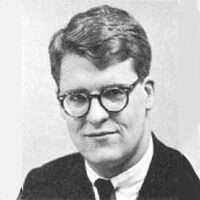Stephen Oberbeck
- 1968

Fellowship Title:
- Art and Technology in Europe
Fellowship Year:
- 1968
A Synaesthetic Smorgasbord: Venice & Kassel
July 22, 1968 Amsterdam—International art festivals are like childrens’ birthday parties. They tend to over-indulge you with ice cream and cake. The recent art exhibitions at Venice and Kassel, Germany—Biennale and Documenta IV—were no exception. After both, one feels the need for some sort of synaesthetic Brioschi. Both events have taken their rightful place in the pantheon of major art whing-dings; Venice’s Biennale as the party to be at, and Kassel’s Documenta as the party where you see the latest in artistic fashion. The Biennale, this year the 34th, displays its art from national pavilions, while Documenta exhibits more by style than by nationality. Prizes are awarded at the Biennale, which has made for some sly Venetian politiking in the past; Documenta bestows no prizes—but there is a Machiavellian contest for gallery space. Like the good dowager she is, the Biennale ends up with a respectable artistic guest-list that runs from traditional-decorative to ultra-modern. By comparison, Documenta looks like a Klopstockian congress of rampant Avangardismus. Christo’s “Package” deal: The gasbag was no beacon Champagne &
Cinema: Man Beyond the Biosphere
July 15, 1968 Mr. Oberbeck is an Alicia Patterson Fund award winner, on leave from Newsweek, Inc. This article may be published, with credit to S. K. Oberbeck and the Alicia Patterson Fund. London—Of about 40 movies I saw here in the past months, far and away the best of them was, an Anglo-American MGM production: Stanley Rubrick’s “2001,” a visually awesome “space odyssey” that put into popular orbit some unsettling scientific speculations and critical philosophical questions. The most significant feature of “2001” was that its true stars were not Keir Dallea or Gary Lockwood (who play two cosmonauts) but roughly two million years of man’s technological development from club-wielding ape to a space-walking astronaut. Though present in a fabulous, leviathan array of glossy space-ware, technology in “2001” is presented in apotheosis as a titanic, crimson-eyed, sinisterly soft-spoken computer named Hal 9000 who is capable of demonstrating a startling spectrum of human traits, including mutiny and murder. In fact, technology, functions as plot and action as well as character in this stratospheric, $10-million epic—as direct,
Massage Parlors for Jaded Senses
July 15, 1968 London—In the synergintic, all-at-once world posited by environmentalists such as Lewis Mumford, Marshall MacLuhan or Gyorgy Kepes, the glittering, twittering walk-in work of art—that proliferating sensorial massage parlor—is an example of the modern artist’s preoccupation with a new scale, form and space. In museums, galleries and arts festivals on both sides of the Atlantic, the most modern artists, with something of the cool come-hither of a psychedelics salesman, are constructing wrap-around experiences and spaces that are strikingly different from our normal environment. Painting and sculpture, in the hands of these environmental artists, seem to be synthesizing each other, and both become more and more like sumptuously colored and highly modeled architecture through which spectators can stroll, sometimes dwarfed by the creation they explore. Painting has not come down off the wall so much as it has become the wall, often one that curves or twists. Whole rooms full of found or created objects are now assembled to produce an enveloping esthetic experience by combine-artists like Claes Oldenburg, Edward Kienholz, Marisol and George
Art and Technology: “Cybernetic Serendipity”
June 10, 1968 London—Several years ago, discussions of art and technology usually began with the handy citation of C. P. Snow’s famous “two cultures” assertion that art and science did not mix, that “literary culture,” traditionally the lodestone of the arts, was separated from “scientific culture” by a yawning gap. In the most modern arts today, the gap no longer yawns. It hardly exists. Even a passing glance at what is happening to the visual and performing arts will confirm that the scene is anything but Snowbound. In London, as in New York, art and science intertwine like sine-waves crisscrossing on the screen of an oscilloscope. Wrap-Around Media For manifestations of art and the materials and methods of science are visible everywhere in the wraparound media of daily living—in the ultra-hip television commercial or the multi-screen movie, in museums where kinetic constructions flash, sputter or gyrate; in urban parks and plazas where monumental, brightly colored sculptures in a variety of new materials gladden the drab cityscape; in the frantic stroboscopic, psychedelic light shows of
